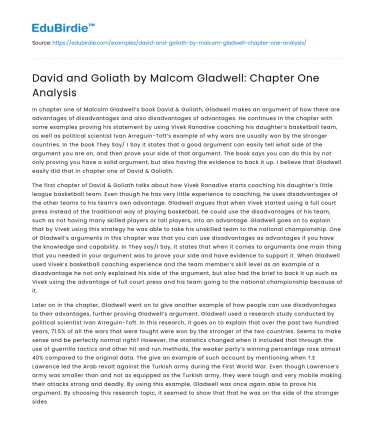In chapter one of Malcolm Gladwell’s book David & Goliath, Gladwell makes an argument of how there are advantages of disadvantages and also disadvantages of advantages. He continues in the chapter with some examples proving his statement by using Vivek Ranadive coaching his daughter’s basketball team, as well as political scientist Ivan Arreguin-Toft’s example of why wars are usually won by the stronger countries. In the book They Say/ I Say it states that a good argument can easily tell what side of the argument you are on, and then prove your side of that argument. The book says you can do this by not only proving you have a solid argument, but also having the evidence to back it up. I believe that Gladwell easily did that in chapter one of David & Goliath.
The first chapter of David & Goliath talks about how Vivek Ranadive starts coaching his daughter’s little league basketball team. Even though he has very little experience to coaching, he uses disadvantages of the other teams to his team’s own advantage. Gladwell argues that when Vivek started using a full court press instead of the traditional way of playing basketball, he could use the disadvantages of his team, such as not having many skilled players or tall players, into an advantage. Gladwell goes on to explain that by Vivek using this strategy he was able to take his unskilled team to the national championship. One of Gladwell’s arguments in this chapter was that you can use disadvantages as advantages if you have the knowledge and capability. In They say/I Say, it states that when it comes to arguments one main thing that you needed in your argument was to prove your side and have evidence to support it. When Gladwell used Vivek’s basketball coaching experience and the team member’s skill level as an example of a disadvantage he not only explained his side of the argument, but also had the brief to back it up such as Vivek using the advantage of full court press and his team going to the national championship because of it.
Save your time!
We can take care of your essay
- Proper editing and formatting
- Free revision, title page, and bibliography
- Flexible prices and money-back guarantee
Later on in the chapter, Gladwell went on to give another example of how people can use disadvantages to their advantages, further proving Gladwell’s argument. Gladwell used a research study conducted by political scientist Ivan Arreguin-Toft. In this research, it goes on to explain that over the past two hundred years, 71.5% of all the wars that were fought were won by the stronger of the two countries. Seems to make sense and be perfectly normal right? However, the statistics changed when it included that through the use of guerrilla tactics and other hit and run methods, the weaker party’s winning percentage rose almost 40% compared to the original data. The give an example of such account by mentioning when T.E Lawrence led the Arab revolt against the Turkish army during the First World War. Even though Lawrence’s army was smaller than and not as equipped as the Turkish army, they were tough and very mobile making their attacks strong and deadly. By using this example, Gladwell was once again able to prove his argument. By choosing this research topic, it seemed to show that that he was on the side of the stronger sides winning the war, and not the smaller countries. By then adding the details about the smaller countries using guerilla warfare, it seemed that Gladwell was again showing that disadvantages can be used as advantages when the time is right and people know how to use such disadvantages to their advantage. Gladwell then further proves what said he was on in the argument by giving the example of Lawrence and how Lawrence used the disadvantage of a small, unequipped army to an advantage army that can easily do hit n runs against a much larger force.
Arguments are one type of way for a person to express his or her side of an opinion. It’s important for people to be able to express their beliefs on a matter as long as they have a few things to support their argument. In the book They Say/I Say it states that a strong argument shows what side of the argument you are on and also have enough evidence to be able to support your argument. In chapter one of David & Goliath I believe that Gladwell did both of these. He had the argument that disadvantages can be used as advantages, stated what side of the argument he was on, and then had evidence to support his argument. The book They Say/I Say helped me better understand how an argument essay works, how I can easily read and understand it, and also make me a better writer for an argument essay.






 Stuck on your essay?
Stuck on your essay?

